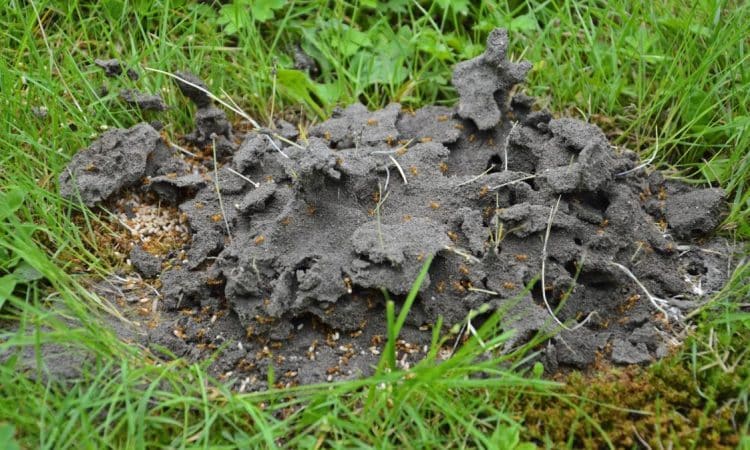
Ants in the garden are not actually pests. On the contrary, they are very useful and an integral part of our ecosystem. Nevertheless, ants in the garden can become a nuisance.
This is because one of their favorite foods is honeydew, the excretion of aphids. The ants care for and protect the aphids so that they can increase their population. Over time, infested plants can be damaged by the aphids.
Another pest aspect is where the ants live. They not only build their nests under sidewalk or patio slabs and can thus cause the stones to become loose. Some species also build ant hills under lawns, which disturb some garden owners.
Which ant species live under the lawn?
In our latitudes, it is mainly the black trail ant (Lasius niger) and the yellow meadow ant (Lasius flavus) that can be found, which prefer to build their nests under lawns. There is also the turf ant (Tetramorium caespitum), which lives mainly in sandy and dry places.
The nests can be recognized above ground by mounds of earth that can sometimes reach the size of a molehill. This does not look nice in the lawn. It can also happen that the ants’ activity means that there is no longer any ground contact. As a result, the grass can absorb less water and nutrients or, in extreme cases, none at all. The lawn then turns yellow and gradually dies.
How to get rid of ants in your lawn
Ants do not always have to be killed; you can first try to drive them away. There are several ways to do this:
- Regular lawn care: Mow the lawn weekly and water it intensively. This makes the habitat less attractive for ants, as they prefer it dry.
- Use natural fragrances: Lavender, lemon balm, cinnamon, cloves and citrus fruits can keep ants away. Sprinkle these substances on ant nests and pathways.
- Use coffee grounds: Sprinkle dried coffee grounds directly on and around the ants’ nest. The strong odor disturbs the ants’ orientation.
- Relocation: Place a clay pot filled with wood wool or loose soil over the ants’ nest. If it is prepared with jam on top, this will also attract the insects. As soon as the ants have moved, you can move the pot to a remote location.
Fighting ants in the lawn: these remedies are available
Sometimes you will not be successful with the home remedies mentioned to drive the ants away. You may then be forced to fight the insects. There are natural and chemical remedies for this.
You should always prefer the former, as chemical insecticides are also harmful to aquatic organisms or bees in the long term. And last but not least, they are a danger to your pets and children. Some ant repellents contain active ingredients that are banned in agriculture.
The fact that these active ingredients are still available to buy is due to the fact that ant repellents are not covered by the Plant Protection Act, but by the Biocides Ordinance. And this has its own rules, approvals and active substance authorizations.
Insects – sometimes annoying, sometimes useful
Larger than character
Larger than character
Natural repellents against ants: Nematodes and diatomaceous earth
The antagonists of ants are nematodesi.e. threadworms. They can be bought from specialist shops in powder form to prepare a solution, which is then applied between April and September. The soil must be moist and kept moist for two weeks.
Ants are killed by the nematodes within 24 to 48 hours if they come into direct contact with them. If there are nematodes in the soil, ants feel disturbed in their nest building and migrate.
Diatomaceous earthalso known as diatomaceous earth, is also a powder. It is made from unicellular crustaceans and damages the wax layer on the ants’ chitinous shell, causing them to dry out.
Diatomaceous earth is a natural remedy against ants
Diatomaceous earth must be introduced directly into the ants’ nests in order to be effective.
A more radical and not animal-friendly method is, boiling water into the soil. This scalds the animals. However, the plants usually suffer as well: In many cases, their roots die after heat treatment.
Insecticides against ants in the lawn
As a last option, there are chemical agents against ants. According to the Pest Science Institute, they are available in spray form, for example. These contain contact insecticides that kill ants and other pests within a few minutes.
Another option is to use feeding baits. In addition to an attractant that is very attractive to ants, these also contain a poisonous substance that kills the ants after a short time. The ants carry the bait into the nest and feed larvae and queens with the poisoned bait. Feeding baits should only ever be applied in special bait boxes to prevent other animals from coming into contact with them.
There are also sprinkling and pouring agents that combine the properties of insect sprays and feeding baits. According to the Pest Research Institute, this method is particularly effective in combating black ants and lawn ants. However, these products pose a particular danger to bees and should therefore not be used.

